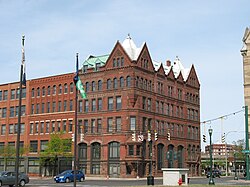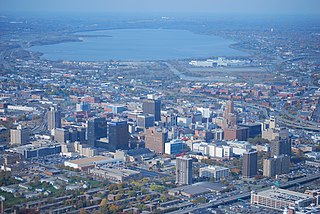
Downtown Syracuse is the economic center of Syracuse, New York, and Central New York, employing over 30,000 people, and housing over 4,000.

The Upstate Medical University Arena at Onondaga County War Memorial is a multi-purpose arena located in Syracuse, New York. It is part of the Oncenter Complex. Designed by Edgarton and Edgarton and built from 1949 through 1951, the structure is significant as an example of a World War I, World War II and Aroostook War commemorative and as "an early and sophisticated example of single-span thin-shell concrete roof construction." It was listed on the National Register of Historic Places in 1988. The Upstate Medical University Arena has been renovated twice, in 1994 and 2018.

This is a list of the properties and districts listed on the National Register of Historic Places listings in Onondaga County, New York. The locations of National Register properties and districts may be seen in a map by clicking on "Map of all coordinates". There are 162 properties and districts listed on the National Register in the county. Of those, 54 are outside the city of Syracuse, and are listed here, while the rest are covered in National Register of Historic Places listings in Syracuse, New York. One property, the New York State Barge Canal, spans both the city and the remainder of the county.

The Hawley–Green Historical District is in the Near Northeast neighborhood of Syracuse, New York. The name comes from the district's two principal streets, Hawley Avenue and Green Street. As Hawley–Green Street Historic District, the district was listed on the National Register of Historic Places in 1979. In 2018 its boundaries were increased to include a number of adjacent streets with similarly styled buildings.
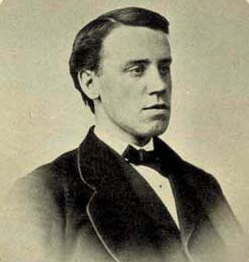
Joseph Lyman Silsbee was a significant American architect during the 19th and 20th centuries. He was well known for his facility of drawing and gift for designing buildings in a variety of styles. His most prominent works ran through Syracuse, Buffalo and Chicago He was influential as mentor to a generation of architects, most notably architects of the Prairie School including the famous architect Frank Lloyd Wright.
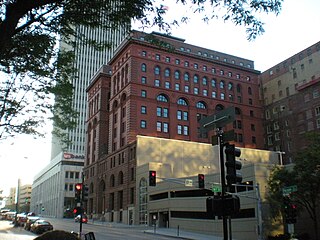
The Omaha National Bank Building was built in 1888–89 at 1650 Farnam Street in Downtown Omaha, Nebraska. Built in the Italian Renaissance style, the building was saved from demolition by a rehabilitation in 1978. Listed on the National Register of Historic Places in 1972, the building was originally known as the New York Life Insurance Building; it was renamed in 1906.

The Gridley Building, built in 1867 and known previously as the Onondaga County Savings Bank Building, is a prominent historic building on Clinton Square and Hanover Square in Syracuse, New York, United States. It was designed by Horatio Nelson White and was built adjacent to what was then the Erie Canal and is now Erie Boulevard.

Syracuse Savings Bank Building, also known as Bank of America building, is a historic building in Syracuse, New York designed by Joseph Lyman Silsbee, then aged 26.

The Pi Chapter House of Psi Upsilon Fraternity is a building on the Syracuse University campus built in 1898 that was designed by Wellington W. Taber. It was listed on the National Register of Historic Places in 1985. It is significant for its Neoclassical design, and its historic role as "the oldest intact surviving fraternity residence at Syracuse University and for its association with the emergence of fraternal organizations as major components of Syracuse college life at the turn of the 20th century."

Grace Episcopal Church is an historic Episcopal parish in Syracuse, New York. The Gothic Revival building was designed by Horatio Nelson White and was built in 1876. It is located at 819 Madison Avenue near Syracuse University. On March 20, 1973, it was listed on the National Register of Historic Places.
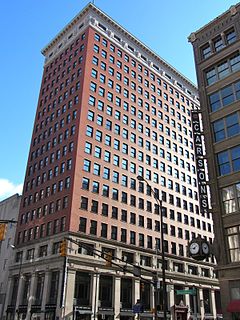
The Barnes and Thornburg Building is a high rise in Indianapolis, Indiana originally known as the Merchants National Bank Building. In 1905, the Merchants National Bank and Trust Company engaged the architectural firm of D. H. Burnham & Company of Chicago to design a new bank headquarters on the southeastern corner of the Washington and Meridian streets, the most important intersection in Indianapolis. Initial occupancy of the lower floors took place in 1908, while the upper floors were not completed until 1912.
The National Register of Historic Places listings in Syracuse, New York are described below. There are 109 listed properties and districts in the city of Syracuse, including 19 business or public buildings, 13 historic districts, 6 churches, four school or university buildings, three parks, six apartment buildings, and 43 houses. Twenty-nine of the listed houses were designed by architect Ward Wellington Ward; 25 of these were listed as a group in 1996.

The Gere Bank Building is a five-story building located on Water Street in Syracuse, New York. It was designed by Charles Colton, and built in 1894. It is distinctive for its facade and use of contrasting materials. The cost of the building was $150,000, including nearly $50,000 for fireproof vaults in a room beneath the sidewalk. The building was added to the National Register of Historic Places in 1972. It is part of the Hanover Square Historic District. In the warm weather months, entertainment is common on the plaza around the fountain. Workers in the surrounding office buildings and retail establishments often lunch there.

The Walnut Park Historic District is located in the University Hill neighborhood of Syracuse, New York, adjacent to the Syracuse University campus. The district was added to the National Register of Historic Places in 1983.
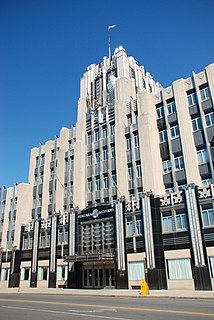
The Niagara Mohawk Building is an art deco classic building in Syracuse, New York. The building was built in 1932 and was headquarters for the Niagara Mohawk Power Corporation, what was "then the nation's largest electric utility company". The company has since been acquired by merger into National Grid plc. It was listed on the National Register of Historic Places as the Niagara Hudson Building in 2010.

Charles Erastus Colton was an American architect who worked in Syracuse, New York.

New York Central Railroad Passenger Station is a former railroad station in Syracuse, New York. It was listed on the National Register of Historic Places on September 11, 2009. The former station currently is the home to Spectrum's Central New York operations.
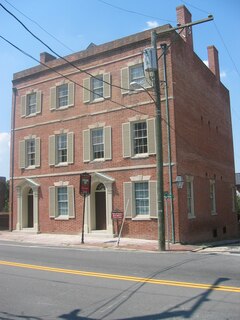
Farmers' Bank is the first bank museum of its kind found in Virginia. Farmers' Bank was incorporated in 1812 and the Petersburg, Virginia branch opened in 1817.

Île-Verte Lighthouse is a lighthouse on Île Verte in Notre-Dame-des-Sept-Douleurs, Quebec, Canada. Completed in 1809, it is the oldest lighthouse on the Saint Lawrence River and the third oldest in Canada. The Lighttower, which is 17 metres (56 ft) in height.

The Clinton–Hardy House on S. Guthrie in Tulsa, Oklahoma was built in 1919. It was designed by architect George Winkler and built for Mr. and Mrs. Lee Clinton. It was listed on the National Register of Historic Places in 1979.
